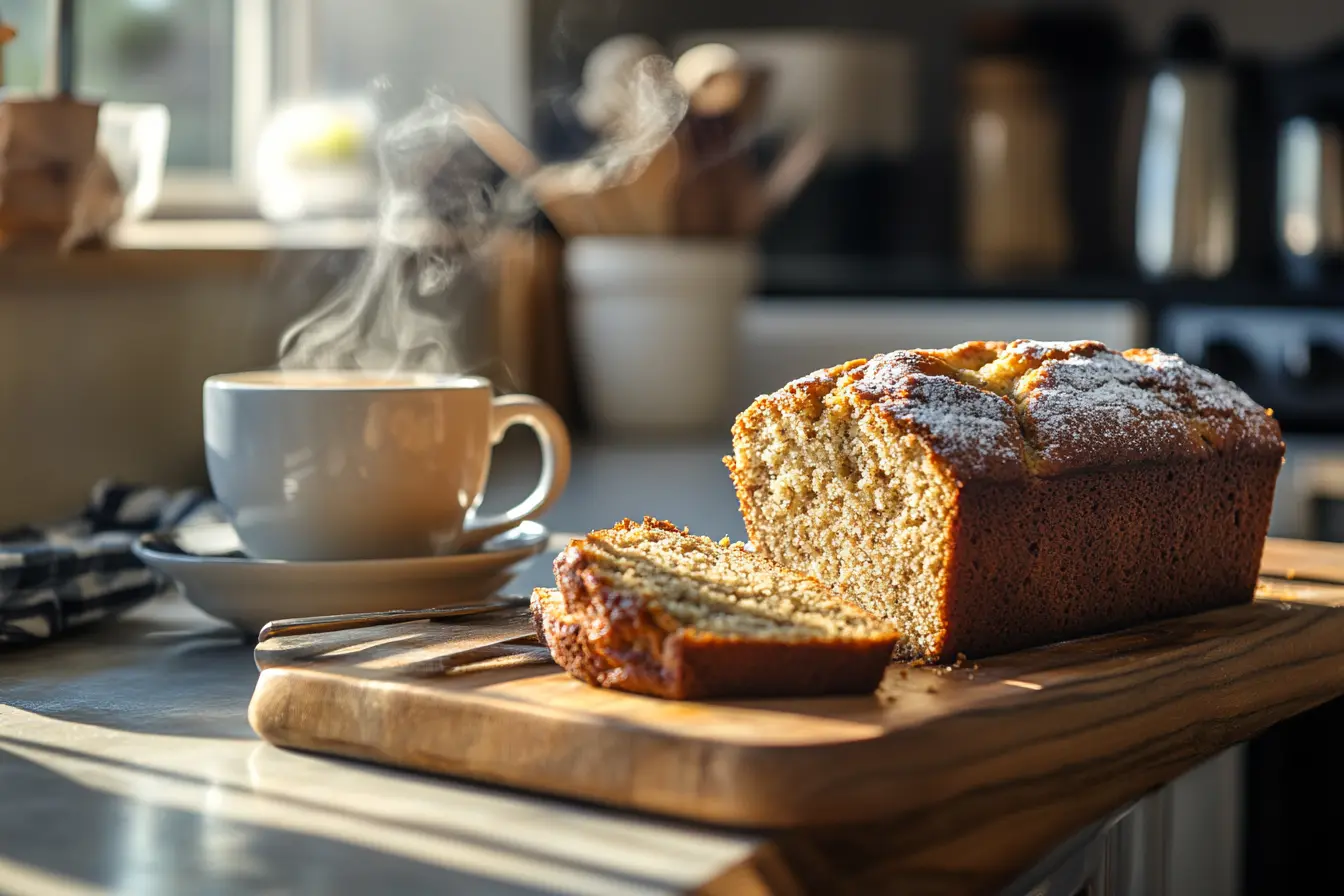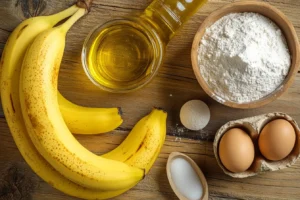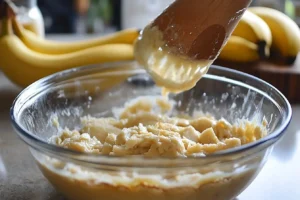Banana bread is a timeless classic that has found its way into kitchens around the globe. Whether you’re looking for a comforting treat or a versatile recipe for overripe bananas, a banana bread recipe made with oil is a perfect choice. This guide delves into all the secrets, from selecting the right ingredients to mastering baking techniques, ensuring your loaf is irresistibly moist and delicious. Let’s dive in!
Introduction to Banana Bread
History and Origin of Banana Bread
Banana bread, often dubbed the “comfort food of baking,” dates back to the Great Depression when home bakers found creative ways to use overripe bananas instead of discarding them. Over the years, this recipe evolved into the modern versions we know and love. And while butter has long been a go-to fat, baking with oil has surged in popularity for its ability to create an exceptionally moist and tender loaf.
Learn how simple substitutions, like using bananas instead of butter, have transformed classic recipes into healthier alternatives in our guide on using bananas instead of butter in baking.
Popularity and Variations
It’s no wonder banana bread is a household favorite! Its versatility allows bakers to tweak ingredients, making it vegan, gluten-free, or loaded with delightful add-ins like chocolate chips and nuts. Using oil in banana bread ensures a moist texture, making it a foolproof option for bakers of all skill levels.
Benefits of Using Oil in Banana Bread Recipes
So, why choose oil over butter? Oil is easier to work with and doesn’t require creaming, saving time in the kitchen. Plus, it locks in moisture better than butter, ensuring your banana bread recipe made with oil stays soft even after a few days. For a healthier twist, olive or coconut oil can replace traditional vegetable oils, but the choice depends on your taste preferences.
Curious about what you can substitute for oil in your recipe? Explore creative options in our detailed article on what to substitute for oil in banana bread.
Ingredients for Oil-Based Banana Bread
Essential Ingredients for Banana Bread
Creating the perfect banana bread recipe made with oil starts with selecting the right ingredients. While this recipe is straightforward, every item plays a crucial role in flavor and texture. You’ll need ripe bananas – the riper, the better, as they add natural sweetness and a deep banana flavor. Flour forms the foundation, while sugar ensures the bread’s signature sweetness. Oil, the star of this recipe, delivers a moist and tender crumb. Eggs are essential for structure, and a leavening agent like baking soda guarantees a beautiful rise.
Choosing the Right Oil for Banana Bread
When it comes to oil, the options are plentiful. Vegetable oil is a popular choice due to its neutral flavor, but alternatives like canola or sunflower oil work just as well. If you’re feeling adventurous, olive oil adds a subtle fruity note, and coconut oil introduces a hint of tropical sweetness. Whatever you choose, ensure it complements the flavor of the bananas and doesn’t overpower the loaf’s natural charm.
For more inspiration on crafting the perfect loaf, check out this alternative recipe for banana bread without butter, which emphasizes simple and flavorful ingredients.
Optional Add-ins for Extra Flavor
Here’s where you can get creative! Classic additions like chopped walnuts or pecans add crunch, while chocolate chips bring a touch of indulgence. For a healthier twist, consider folding in flaxseeds, chia seeds, or dried fruits. These add-ins don’t just elevate the flavor—they also make your banana bread recipe made with oil more nutritious. Remember, the key is balance; don’t overdo it, or you risk overwhelming the bread’s soft texture.
Step-by-Step Preparation Guide
Preparing the Batter for Banana Bread
The batter is the heart of any banana bread recipe made with oil. To begin, mash your ripe bananas thoroughly in a large mixing bowl. The smoother they are, the better the texture of your bread. Next, add your oil—whether it’s vegetable, canola, or olive oil—and sugar, mixing until the combination is well-blended. Follow up with eggs, which should be whisked in one at a time to ensure an even distribution. This step is crucial, as it creates a light and airy base for the batter.
Mixing Techniques for the Perfect Consistency
When incorporating the dry ingredients, you’ll want to avoid overmixing. Sift the flour, baking soda, and a pinch of salt together in a separate bowl first. Then, gently fold the dry mixture into the wet ingredients in batches. This step is vital because overmixing can lead to dense banana bread—a common issue even with an oil-based banana bread recipe. Add any optional ingredients like nuts or chocolate chips at this stage for an even distribution.
Preparing the Baking Pan
Before pouring the batter, prepare your baking pan to ensure your loaf doesn’t stick. Lightly grease it with oil or line it with parchment paper for effortless removal. The parchment paper helps prevent sticking and makes cleanup easy. After preparing the pan, pour in the batter and smooth the top with a spatula for an even finish. At this stage, your banana bread is ready to bake!
Baking Instructions and Tips
Optimal Baking Temperature for Banana Bread
To bake your banana bread recipe made with oil to perfection, preheat your oven to 350°F (175°C). This temperature ensures even cooking without drying out the loaf. Use the middle rack of your oven, as it provides the most consistent heat. While it might be tempting to increase the temperature for faster baking, doing so could cause the bread to brown too quickly on the outside while remaining raw inside.
Determining Doneness Without Guesswork
Knowing when your banana bread is done can be tricky, but it’s straightforward if you follow these tips. Start by setting your timer for 50 minutes and checking the bread regularly after this point. Insert a toothpick or skewer into the center of the loaf. If it comes out clean or with only a few crumbs, the bread is ready. Keep in mind, using oil in banana bread often makes it slightly denser than butter-based recipes, so the texture might differ slightly.
Cooling and Slicing for Best Results
Once your banana bread is baked, resist the urge to slice it immediately! Allow the loaf to cool in the pan for about 10 minutes. Afterward, transfer it to a wire rack to cool completely. Slicing the bread too early may cause it to crumble. For clean, precise slices, use a serrated knife. Allowing proper cooling helps the flavors to fully develop, making your oil-based banana bread taste even better the following day.
Nutritional Information and Considerations
Calorie Count per Serving
A single slice of this banana bread recipe made with oil offers a balanced combination of energy and flavor. On average, a standard serving contains around 200 to 250 calories, depending on the ingredients you choose. Using oil instead of butter slightly reduces saturated fat, making it a more heart-friendly option. Additionally, the natural sweetness of ripe bananas allows you to cut back on added sugar without sacrificing taste.
Macronutrient Breakdown for Banana Bread
Each slice of this delicious bread typically includes a mix of carbohydrates, healthy fats, and protein. Carbohydrates, primarily from the bananas and flour, offer a quick source of energy. The oil contributes healthy fats, particularly if you opt for olive or avocado oil. While protein content is moderate, incorporating nuts such as walnuts or pecans can boost protein levels and provide healthy omega-3 fatty acids.
Health Benefits of Ingredients
This oil-based banana bread recipe is more than just a tasty treat—it’s a great way to incorporate wholesome ingredients into your diet. Bananas are packed with potassium, vitamin C, and fiber, promoting heart health and digestion. Meanwhile, oils like olive and coconut oil are rich in monounsaturated fats, which support overall well-being. For an extra health boost, consider replacing a portion of all-purpose flour with whole wheat flour.
Considerations for Dietary Needs
This recipe can be easily adapted for various dietary needs. Swap in a plant-based egg substitute for a vegan version or use gluten-free flour blends for those with gluten sensitivities. Making small changes like these ensures everyone can enjoy a slice of this moist and flavorful banana bread recipe made with oil.
Common Variations of Oil-Based Banana Bread
Vegan Banana Bread Options
For those looking to make a plant-based banana bread recipe made with oil, the adjustments are surprisingly simple. Replace eggs with flaxseed or chia seed gel, which provides similar binding properties. Choose plant-based milk like almond or soy to enhance the batter’s moisture further. Since oil is already vegan, you won’t need to swap it out, making this variation as effortless as it is delicious.
Gluten-Free Adaptations for Banana Bread
Gluten sensitivity doesn’t mean you have to forgo this classic treat! Just substitute regular flour with a gluten-free blend that contains xanthan gum or guar gum for structure. Adding almond meal to the gluten-free flour enhances richness and keeps the loaf moist. Since oil improves the texture of banana bread, it works wonderfully with gluten-free ingredients, ensuring your loaf remains soft and tender.
Incorporating Unique Flavors into Banana Bread
If you want to elevate your oil-based banana bread recipe, try experimenting with spices and additional flavors. A dash of cinnamon or nutmeg adds warmth, while shredded coconut introduces a tropical twist. For fruit enthusiasts, adding chopped apples or blueberries introduces a delightful burst of flavor. Chocolate enthusiasts can add cocoa powder to the batter or top the loaf with chocolate chips for an indulgent touch.
Adapting to Your Preferences
The charm of banana bread lies in its versatility. Whether you prefer a nutty crunch, fruity sweetness, or chocolaty decadence, this banana bread recipe made with oil can easily be customized. These variations add excitement to your baking and guarantee there’s a version for everyone to enjoy.
Frequently Asked Questions (FAQs)
Can I substitute butter for oil in banana bread?
Yes, you can substitute butter for oil in this banana bread recipe made with oil, but it will change the texture slightly. Oil creates a lighter, more moist loaf, while butter gives a denser texture and a richer flavor. If you prefer butter, melt it before adding it to the batter for even distribution. However, oil remains the easier and healthier option for a consistent outcome.
What’s the best way to store banana bread to keep it moist?
Storing your banana bread properly is essential to maintain its moist texture. After it cools completely, wrap it tightly in plastic wrap or store it in an airtight container. Keep it at room temperature for up to three days or refrigerate it for up to a week. Using oil in the recipe already helps retain moisture, so you’ll find it stays fresh longer than butter-based versions.
Can I freeze banana bread?
Absolutely! Freezing banana bread is an excellent way to maintain its freshness. Slice the loaf before freezing, so you can easily grab individual servings. Wrap each slice in plastic wrap and store them in a resealable freezer bag. When you’re ready to enjoy, thaw at room temperature or microwave briefly for a warm, soft treat.
What’s the best type of oil to use for banana bread?
Vegetable oil is the most popular choice for banana bread because of its neutral flavor, but there are other excellent alternatives as well. Olive oil adds a unique richness, while coconut oil gives a mild sweetness. For a healthier alternative, you can use avocado oil, which is rich in nutrients and still delivers a moist loaf. The key is choosing an oil that enhances the flavor of the bananas without overpowering them.
How can I make my banana bread healthier?
There are several ways to make this oil-based banana bread recipe healthier. Swap all-purpose flour for whole wheat flour to add fiber, and reduce the sugar a bit, as ripe bananas offer natural sweetness. Opt for healthier oils like olive or avocado, and add mix-ins like flaxseeds or chia seeds for an extra nutritional boost.
Why did my banana bread turn out dense?
A dense loaf often results from overmixing the batter or not using enough leavening agent. To prevent this, gently fold the wet and dry ingredients together until just combined. Additionally, make sure your baking soda is fresh, as old leavening agents lose their effectiveness. Following these tips ensures your oil-based banana bread turns out light and fluffy every time.
Conclusion
In summary, this banana bread recipe made with oil offers a perfect balance of simplicity, flavor, and adaptability. Whether you’re a seasoned baker or just starting out, this recipe ensures success with minimal effort. Using oil not only simplifies the process but also guarantees a moist and tender loaf every time. With the flexibility to accommodate dietary preferences and endless possibilities for creative add-ins, this recipe truly stands out as a staple for any kitchen.
So, grab those ripe bananas, choose your favorite oil, and start baking your way to a delicious homemade treat that everyone will love!


